Common menu bar links
Turkey industry adapting to new Canadian demographics
Archived Content
Information identified as archived is provided for reference, research or recordkeeping purposes. It is not subject to the Government of Canada Web Standards and has not been altered or updated since it was archived. Please "contact us" to request a format other than those available.
by Margaret Morris, Statistics Canada
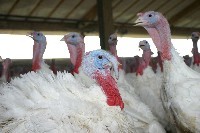
According to the 2006 Census of Population, Canada has three times as many one-person households as those with five or more people. With households declining in size over the past century, an increasingly older population and busy lifestyles, it’s not difficult to understand why products packaged in a more consumer-friendly format are appreciated. To meet consumer demand for these products, turkey producers are raising heavier birds and sales are shifting from whole turkeys to processed turkey products. The Census of Agriculture reported that, on May 16, 2006, there were 5% fewer turkeys on Canadian farms than in 2001 but that production in the preceding year had increased by 6% over the previous five years. A move to larger birds has contributed to this shift.
In recent years new turkey food products have appeared on grocery store shelves and in restaurants. The introduction of value-added products such as turkey sausages and turkey bacon has allowed this particular bird to compete directly with traditional red-meat based products. The range of turkey products has increased too, with sliced turkey breast, ground turkey, turkey kebabs and pre-stuffed turkeys increasingly available.
How much turkey do we eat?
While beef consumption has fallen since the late 70’s, the annual per capita apparent consumption of boneless turkey has remained relatively stable, at an estimated 2.2 kilograms in 2006 (Figure 1). By comparison, Canadian consumption of chicken has increased by approximately 50% over the last 20 years. Pork consumption has been more variable.
Figure 1
Per capita apparent consumption of turkey, beef, chicken and pork, 1965 to 2006
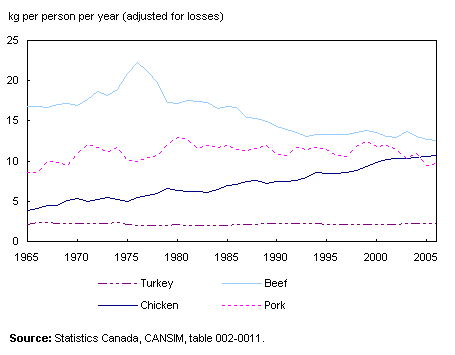
Although turkey consumption per person has been stable, the industry has grown. In fact, over the past 25 years, according to production data from Production of Poultry and Eggs, 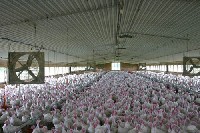 the industry has expanded by about 70% (in terms of weight) partly because of a growing Canadian population and, more recently, rising exports. Farm cash receipts from turkeys in Canada totaled $278.5 million in 2006.
the industry has expanded by about 70% (in terms of weight) partly because of a growing Canadian population and, more recently, rising exports. Farm cash receipts from turkeys in Canada totaled $278.5 million in 2006.
The Census of Agriculture reported that, on May 16, 2006, there were 7.7 million turkeys on farms across Canada, 5% fewer birds than in 2001. However, 2006 Census data show that production has increased: Canadian farmers produced 188.7 million kilograms of turkey (live weight) in 2005, up 6% from 2000 (Table 1).
While production increased, the number of farms reporting turkeys declined by nearly one-quarter. In 2006, 3,174 Canadian farms reported turkeys on their operation, down from 4,176 in 2001. This may reflect consolidation in the industry, as some operations expanded their production while others left the industry altogether.
Most of the turkey production in Canada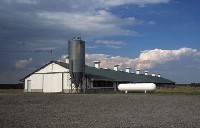 takes place in Ontario with Quebec a distant second, having less than half of Ontario’s production (Table 1). An operation usually raises between one and seven flocks a year, depending on the size of the birds produced and the size of the operation.
takes place in Ontario with Quebec a distant second, having less than half of Ontario’s production (Table 1). An operation usually raises between one and seven flocks a year, depending on the size of the birds produced and the size of the operation.
On Census Day in 2006, the average number of turkeys per farm was about 2,400 and provincial averages ranged from a few hundred to over 4,000. But, when these farms are broken into small and large operations the divide becomes rather pronounced. Farms which reported fewer than 300 turkeys (the greatest number of birds permitted in some provinces not requiring quota) numbered 2,674 and reported 55,806 turkeys. Only 500 operations reported having 300 or more turkeys on Census day, but they held over 7.6 million birds. Thus, average flock size for the large farms amounted to over 15,000 while the smaller operations averaged only 21 birds, suited only to home consumption and small local markets.
Supply management
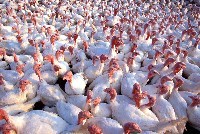 Supply management is a system that uses agricultural production quotas, marketing boards, and the control of trade to regulate agricultural production and prices.
Supply management is a system that uses agricultural production quotas, marketing boards, and the control of trade to regulate agricultural production and prices.
Turkeys are a supply-managed commodity, which means that the supply of turkeys is regulated through import controls and domestic production quotas. The National Farm Products Council oversees the Canadian Turkey Marketing Agency (CTMA), which estimates the demand for turkey annually, determines the required national production, and then distributes this production among the provinces. The provincial boards in turn allocate production to individual producers and ensure that they produce and market within this allocation. The provincial boards negotiate turkey prices with processors, taking into account input costs, supply and demand, storage stocks and the price of competing meats. The agreed-upon price becomes the minimum producers can be paid for their turkeys. In a supply-managed system, producers buy quota from a limited amount available. As such, domestic turkey production is controlled and producers receive a relatively stable return.
In Canada, the CTMA has jurisdiction in all provinces except Prince Edward Island and Newfoundland and Labrador, where turkey production is not registered. In other provinces, unregistered producers can produce turkeys as long as they produce fewer than a specified number per year, a number that varies by province but ranges from 25 to 300 turkeys.
Turkey exports on the up and up
Demand in Canada is highest for white meat, so the turkey export market provides a significant benefit as an outlet for dark meat which is in oversupply on the domestic market. In 2006, Canada exported 27.2 million kilograms of turkey, up 30% from 2001 and representing 16.6% of domestic production. Canada’s turkey meat exports in 2006 went predominantly to South Africa and the United States, but they also had other destinations including the Philippines and Russia. Since the mid-1980s, the turkey industry has developed an export program to accommodate exports of turkey that are produced within the supply management system. Export programs vary from province to province but they frequently operate in such a manner that producers may exceed their domestic production quota allocation if the excess is exported. This exported turkey is marketed at international prices, which are generally lower than domestic prices. Figure 2 shows how turkey exports started to climb in the early 80's after being flat for decades.
Figure 2
Canadian turkey, imports and exports, 1926 to 2006
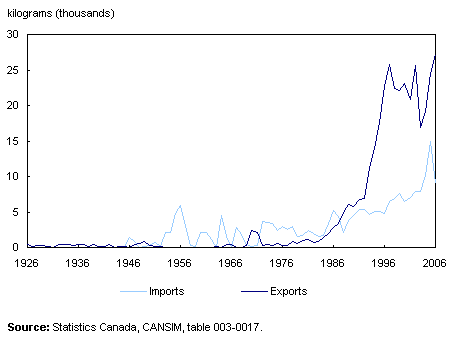
Imported turkeys and turkey products came mainly from the United States in 2006, but also from Chile and Brazil. Turkey imports amounted to the equivalent of 5.5% of domestic production in 2006. Turkey imports to Canada are limited through tariffs to protect the domestic producers. Companies are able to import turkeys at a low tariff rate until they exceed the greater of the limits set in the two major trade agreements to which we belong—North American Free Trade Agreement (NAFTA) and the World Trade Organization (WTO). After that level—5.6 million kilograms of eviscerated weight turkey in 2006—is surpassed, additional imports are subject to significantly higher duty rates. Another program, the Import to Re-Export Program (IREP) allows for turkey products to be imported into Canada tariff free so long as an equivalent weight of turkey is exported. In 2006, 1.2 million kilograms of eviscerated weight turkey was imported and exported under the provisions of this latter program.
According to statistics from the United Nations’ Food and Agriculture Organization (FAO), the United States has more than half the world’s annual turkey production, while Canada, with about 3% of world production, ranks seventh (Table 2).
Turkeys: from the farm to your table
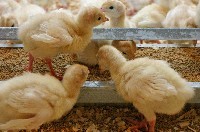 In general, turkeys are described using four different terms. Females are hens, males are toms, smaller turkeys sold as whole birds are broilers (labelled as young turkeys for consumers) and turkeys (both male and female) used to produce fertilized eggs are referred to as breeders. Their classification depends on their final live weight: turkeys marketed as broilers mature in 10 to 12 weeks and generally weigh less than 6.2 kilograms; hens mature in 12 to 15 weeks and weigh from 6.2 to 10.8 kilograms; and toms mature in 17 to 20 weeks and weigh 10.8 kilograms or more. Broilers and hens are primarily destined for the whole-bird market, while toms go primarily for further processing.
In general, turkeys are described using four different terms. Females are hens, males are toms, smaller turkeys sold as whole birds are broilers (labelled as young turkeys for consumers) and turkeys (both male and female) used to produce fertilized eggs are referred to as breeders. Their classification depends on their final live weight: turkeys marketed as broilers mature in 10 to 12 weeks and generally weigh less than 6.2 kilograms; hens mature in 12 to 15 weeks and weigh from 6.2 to 10.8 kilograms; and toms mature in 17 to 20 weeks and weigh 10.8 kilograms or more. Broilers and hens are primarily destined for the whole-bird market, while toms go primarily for further processing.
At breeder farms, hens are bred using artificial insemination. After an incubation period of 28 days, the eggs hatch into baby turkeys, called poults. The poults are checked to see if they are male or female, and then separated accordingly. Separating the sexes simplifies raising and processing the birds because the diet and environment (such as the height of the feeders and waterers) can be specially tailored for each sex. It also ensures a more uniform weight range in each group.
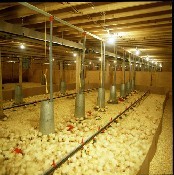 Once hatched and separated, the one-day-old poults move from the hatcheries to turkey farms (a designation process called “placement”). They spend the first five weeks of life, a period called “brooding”, in extra-warm conditions until feathers replace their fluffy yellow down. Once fully feathered—at about six weeks of age—they are transferred to “grow-out” facilities.
Once hatched and separated, the one-day-old poults move from the hatcheries to turkey farms (a designation process called “placement”). They spend the first five weeks of life, a period called “brooding”, in extra-warm conditions until feathers replace their fluffy yellow down. Once fully feathered—at about six weeks of age—they are transferred to “grow-out” facilities.
The turkeys grow and mature for an additional 5 to 15 weeks. On average, it takes approximately 38 kilograms of feed to raise a 14-kilogram tom. Between flocks, producers clean and disinfect their barns before the next flock of poults arrives.
At the processing plant the turkeys are killed, their carcasses plucked and eviscerated, and then quick-chilled. Some turkeys are diverted to further processing to be cut up into parts, while whole birds are processed separately. The turkeys are then packed and delivered to grocery stores and restaurants.
Turkeys – our wild heritage
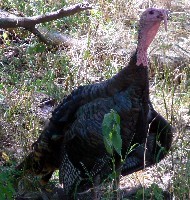 There are many different varieties of turkeys, but they all descend from wild turkeys indigenous to North and South America. Although most commercial turkeys are Broad Breasted Whites, certain heritage breeds—which include such varieties as Narragansett, Bourbon Red, Beltsville Small White, Black Spanish, Jersey Buff, Slate, Royal Palm, White Holland, White Midget and Standard Bronze—have their own niche markets. They are generally more costly and time-consuming to raise and have less white meat; however they are often more disease-resistant, and are strong flyers and foragers.
There are many different varieties of turkeys, but they all descend from wild turkeys indigenous to North and South America. Although most commercial turkeys are Broad Breasted Whites, certain heritage breeds—which include such varieties as Narragansett, Bourbon Red, Beltsville Small White, Black Spanish, Jersey Buff, Slate, Royal Palm, White Holland, White Midget and Standard Bronze—have their own niche markets. They are generally more costly and time-consuming to raise and have less white meat; however they are often more disease-resistant, and are strong flyers and foragers.
In the early 20th century, hunting and loss of habitat severely affected wild turkey populations. In the early 1970s, an estimated 1.3 million wild turkeys roamed North America. Re-introduction programs began in the 1940s and now more than 7 million birds are estimated to be in North America. In the past, wild turkeys typically foraged on forest floors, but today they are also a common sight in farmers’ fields. Marginal farmland reverting to brush has helped expand their range and ensures that wild turkeys have adequate and appropriate habitat.
The modern turkey
Over the years, modern turkey operations have continually responded to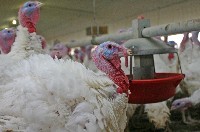 consumer and industry demand by producing turkeys with greater breast width, faster weight gain, and greater feed efficiency to produce an optimal amount of meat for the amount of feed.
consumer and industry demand by producing turkeys with greater breast width, faster weight gain, and greater feed efficiency to produce an optimal amount of meat for the amount of feed.
As far back as the mid-1920s, turkeys were being selected for larger size and greater breast width as well as for their white pinfeathers (to avoid dark spots on the meat). By the 1960s, selective breeding had led to the Broad Breasted White, now the bird of choice in the commercial turkey industry.
Production trends
Production of heavy toms (those weighing more than 11 kilograms, eviscerated) has increased substantially, for the most part to feed the growing demand for processed turkey products in the retail and foodservice sectors. In 2006, 19% of the turkey sold at retail in Canada (by weight) was processed turkey products, compared to only 1% in 1980.
The industry has also moved toward year-round production and marketing. In the past, large numbers of turkey poults were placed (or “started”) in the spring in preparation for Thanksgiving. With the year-round production and marketing, placing poults is now more consistent from month to month (Figure 3).
Figure 3
Placement of turkey poults in 1970 and 2006
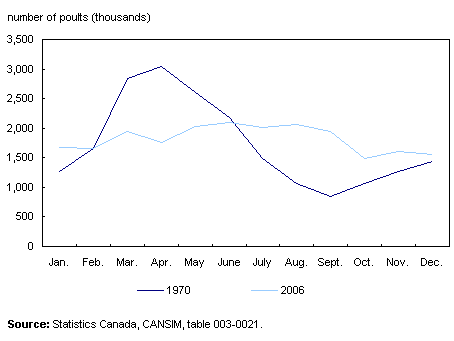
A healthy meat to eat
Many Canadians want to be more discriminating about the food they eat and turkey is often touted as a healthy meat. But how does it compare to other protein sources?
As with all meat, the cut you choose as well as the way you prepare it affects the nutritional value. Skinless white turkey meat has less fat and fewer calories, but dark turkey meat contains more iron. Table 3 shows some of the nutritional composition of light and dark turkey meat, compared to some other protein sources.
From yesterday’s wild bird to today’s platter
So when you sit down to enjoy some turkey this year, whether at Thanksgiving, Christmas, or any other time, think about how that turkey descended from a wild bird indigenous to North and South America. Through efficiency and advancements in modern farming, the turkey industry has ensured that you can enjoy turkey meat not only on festive occasions but throughout the year.
Snoods, wattles and gobbles
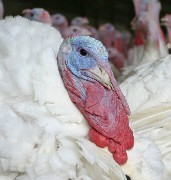 No, this isn’t the title of a new wizards-themed novel, but a few tidbits of turkey trivia for you to gnaw on.
No, this isn’t the title of a new wizards-themed novel, but a few tidbits of turkey trivia for you to gnaw on.
Snood: The snood is the fleshy appendage that hangs down over the male turkey’s beak. When the male turkey is trying to get the attention of a female turkey, the snood can stretch up to twice its length.
Wattle: The wattle is the bumpy skin on a turkey’s neck. It turns brilliant red when the male turkey is strutting his stuff for a female’s attention.
Gobble: This is one of the principal vocalizations of the male turkey. Only the male turkey actually goes “gobble, gobble” while the female turkey clucks softly.

